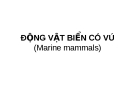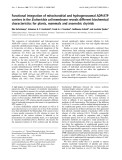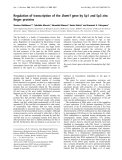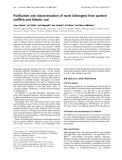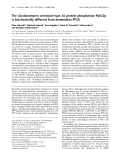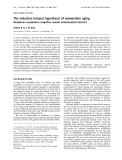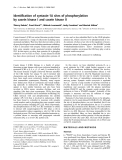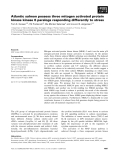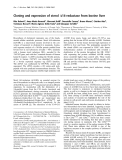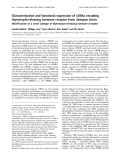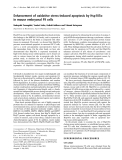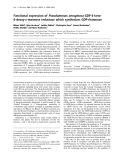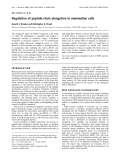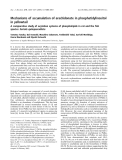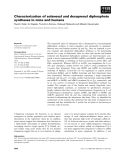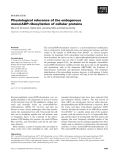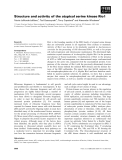
Mammals
-
ĐỘNG VẬT BIỂN CÓ VÚ (Marine mammals) Lớp có vú (Mammalia).– Bộ Cá voi (Cetacea).• Bộ phụ Mysticeti (Cá voi tấm sừng hàm).– Họ Balanopteridae (Cá voi lưng đen)..• Bộ phụ Odontoceti (Cá voi có răng).–
 36p
36p  nomauvang
nomauvang
 19-06-2013
19-06-2013
 103
103
 16
16
 Download
Download
-
The expression of mitochondrial and hydrogenosomal ADP/ATP carriers (AACs) from plants, rat and the anaerobic chytridiomycete fungus Neocallimastix spec. L2 in Escherichia coli allows a functional integration of the recombinant proteins into the bacterial cytoplasmic membrane. For AAC1 and AAC2 from rat, apparent Km values of about 40 lM for ADP, and 105 lM or 140 lM, respectively, for ATP have been determined, similar to the data reported for isolated rat mitochondria.
 10p
10p  system191
system191
 01-06-2013
01-06-2013
 39
39
 4
4
 Download
Download
-
The Sp family is a family of transcription factors that bind to cis-elements in the promoter regions of various genes. Regulation of transcription by Sp proteins is based on interactions between a GC-rich binding site (GGGCGG) in DNA and C-terminal zinc finger motifs in the proteins. In this study, we characterized the GC-rich promoter of the gene for the DNA methyltransferase (Dnmt1) that is responsible for methylation of cytosine residues in mammals and plays a role in gene silencing.
 10p
10p  system191
system191
 01-06-2013
01-06-2013
 39
39
 4
4
 Download
Download
-
Kininogens are multifunctional proteins found so far mainly in mammals. They carry vasoactive kinins as well as participate in defense, blood coagulation and the acute phase response. In this study, novel kininogens were isolated from Atlantic cod (Gadus morhua L.) and spotted wolffish (Anarhichas minor) by papain-affinity chromatography. The molecular mass of cod kininogen determined by MALDITOF mass spectrometry to be 51.0 kDa and it had pI values of 3.6, 3.9 and 4.4.
 8p
8p  system191
system191
 01-06-2013
01-06-2013
 40
40
 5
5
 Download
Download
-
Transglutaminase (TGase) catalyses the post-translational modification of proteins by transamidation of available glutamine residues. While several TGase genes of fish and arthropods have been cloned and appear to have similar structures to those of mammals, no homologous gene has been found in lower eukaryotes. We have cloned the acellular slime mold Physarum polycephalum TGase cDNA using RT-PCR with degenerated primers, based on the partial amino acid sequence of the purified enzyme. The cDNA contained a 2565-bp ORF encoding a 855-residue polypeptide.
 10p
10p  research12
research12
 01-06-2013
01-06-2013
 49
49
 4
4
 Download
Download
-
The Saccharomyces cerevisiae type 2A protein phosphatase (PP2A) Pph22p differs from the catalytic subunits of PP2A (PP2Ac) present in mammals, plants and Schizosaccharomyces pombe by a unique N-terminal extension of approximately 70 amino acids. We have overexpressed S. cerevisiae Pph22p and its N-terminal deletion mutant DN-Pph22p in the GS115 strain of Pichia pastoris and purified these enzymes to apparent homogeneity.
 11p
11p  research12
research12
 01-06-2013
01-06-2013
 46
46
 5
5
 Download
Download
-
A severe challenge to the idea that mitochondrial DNA mutations play a major role in the aging process in mammals is that clear loss-of-function mutations accumulate only to very low levels (under 1% of total) in almost any tissue, even by very old age. Their accumulation is punctate: some cells become nearly devoid of wild-type mitochondrial DNA and exhibit no activity for the partly mitochondrially encoded enzyme cytochrome c oxidase. Such cells accumulate in number with aging, suggesting that they survive indefinitely, which is itself paradoxical....
 7p
7p  research12
research12
 01-06-2013
01-06-2013
 29
29
 3
3
 Download
Download
-
Casein kinases I (CKI) are serine/threonine protein kinases widely expressed in a range of eukaryotes including yeast, mammals and plants. They have been shown to play a role in diverse physiological events including membrane trafficking. CKIa is associated with synaptic vesicles and phosphorylates some synaptic vesicle associated proteins including SV2. In this report, we show that syntaxin-1A is phosphorylated in vitro by CKI on Thr21.
 6p
6p  research12
research12
 01-06-2013
01-06-2013
 40
40
 3
3
 Download
Download
-
Mitogen activated protein kinase kinase (MKK) 3 and 6 are the main p38 mitogen-activated protein kinase activators in mammals. In the present study, three Atlantic salmon MKK6 orthologs were identified. The deduced amino acid sequences of the salmon MKK6 proteins were highly similar to mammalian MKK6 sequences, and they were ubiquitously expressed. All three were shown to be upstream activators of salmon p38.
 16p
16p  research12
research12
 29-04-2013
29-04-2013
 28
28
 3
3
 Download
Download
-
The Na + /H + exchanger is a ubiquitous membrane protein of bacteria, plants and mammals. The first isoform discov-ered (NHE1) is present on the mammalian plasma mem-brane and transports oneH + out of cells inexchange for one extracellular Na + . With solubilization in standard SDS/ PAGE buffer, this protein had a high tendency to aggregate when subjected to elevated temperature. The aggregates were stable and did not dissociate in high concentrations of SDSor 2-mercaptoethanol.
 9p
9p  research12
research12
 29-04-2013
29-04-2013
 47
47
 3
3
 Download
Download
-
Biosynthesis of cholesterol represents one of the funda-mental cellular metabolic processes. SterolD14-reductase (D14-SR) is a microsomal enzyme involved in the con-version of lanosterol to cholesterol in mammals. Amino-acid sequence analysis of a 38-kDa protein puri®ed from bovine liver in our laboratory revealed 90% similarity with a human sterol reductase, SR-1, encoded by the TM7SF2gene, and with the C-terminal domain of human lamin B receptor.
 8p
8p  research12
research12
 29-04-2013
29-04-2013
 39
39
 3
3
 Download
Download
-
Thyrotropin-releasing hormone receptor (TRHR) has already been cloned in mammals where thyrotropin-releas-inghormone (TRH) isknowntoactasapowerful stimulator of thyroid-stimulating hormone (TSH) secretion. The TRH receptor of amphibians has not yet been characterized, although TRH is specifically important in the adaptation of skin color to environmental changes via the secretion of a-melanocyte-stimulating hormone (a-MSH).
 11p
11p  research12
research12
 23-04-2013
23-04-2013
 33
33
 4
4
 Download
Download
-
Hsp105aisoneof themajormammalianheat shockproteins that belongs to the HSP105/110 family, and is expressed at especially high levels in the brain as compared with other tissues in mammals. Previously, we showed that Hsp105a prevents stress-induced apoptosis in neuronal PC12 cells, and is a novel anti-apoptotic neuroprotective factor in the mammalian brain.
 9p
9p  research12
research12
 23-04-2013
23-04-2013
 45
45
 1
1
 Download
Download
-
Pseudomonas aeruginosais an opportunistic Gram-negative bacterium that causes severe infections in a number of hosts from plants to mammals. A-band lipopolysaccharide of P. aeruginosacontains D-rhamnosylated O-antigen. The synthesis of GDP-D-rhamnose, the D-rhamnose donor in D-rhamnosylation, starts from GDP-D-mannose.
 9p
9p  research12
research12
 23-04-2013
23-04-2013
 36
36
 2
2
 Download
Download
-
The elongation phase of mRNA translation is the stage at which the polypeptide is assembled and requires a substantial amount of metabolic energy. Translation elongation in mammals requires a set of nonribosomal proteins called eukaryotic elongation actors or eEFs. Several of these proteins are subject to phosphorylation in mammalian cells, including the factors eEF1A and eEF1B that are involved in recruitment of amino acyl-tRNAs to the ribosome.
 9p
9p  tumor12
tumor12
 22-04-2013
22-04-2013
 36
36
 2
2
 Download
Download
-
It is known that phosphatidylinositol (PtdIns) contains abundant arachidonate and is composed mainly of 1-stea-royl-2-arachidonoyl species in mammals. We investigated if this characteristic of PtdIns applies to the PtdIns from yellowtail (Seriolaquinqueradiata),amarinefish. Incommon with phosphatidylcholine (PtdCho),phosphatidylethanol-amine (PtdEtn) andphosphatidylserine (PtdSer) frombrain, heart,liver,spleen,kidney and ovary,the predominant polyunsaturated fatty acid was docosahexaenoic acid,and levels of arachidonic acid were less than 4.5% (PtdCho), 7.5%(PtdEtn) and3.
 8p
8p  tumor12
tumor12
 20-04-2013
20-04-2013
 39
39
 3
3
 Download
Download
-
To sustain life mammals have an absolute and continual requirement for oxygen, which is necessary to produce energy for normal cell survival and growth. Hence, main-tainingoxygen homeostasis is a critical requirement and mammals have evolved a wide range of cellular and phy-siological responses to adapt to changes in oxygen avail-ability. In the past few years it has become evident that the transcriptional protein complex hypoxia-inducible factor (HIF) is a key regulator of these processes.
 10p
10p  tumor12
tumor12
 20-04-2013
20-04-2013
 36
36
 4
4
 Download
Download
-
The isoprenoid chain of ubiquinone (Q) is determined bytrans-polyprenyl diphosphate synthase in micro-organisms and presumably in mammals. Because mice and humans produce Q9 and Q10 , they are expected to pos-sess solanesyl and decaprenyl diphosphate synthases as the determining enzyme for a type of ubiquinone.
 17p
17p  fptmusic
fptmusic
 12-04-2013
12-04-2013
 28
28
 3
3
 Download
Download
-
The mono(ADP-ribosyl)ation reaction is a post-translational modification that is catalysed by both bacterial toxins and eukaryotic enzymes, and that results in the transfer of ADP-ribose from bNAD + to various acceptor proteins. In mammals, both intracellular and extracellular reactions have been described; the latter are due to glycosylphosphatidylinositol-anchored or secreted enzymes that are able to modify their targets, which include the purinergic receptor P2X7, the defensins and the integrins. ...
 11p
11p  fptmusic
fptmusic
 12-04-2013
12-04-2013
 37
37
 4
4
 Download
Download
-
Rio1 is the founding member of the RIO family of atypical serine kinases that are universally present in all organisms from archaea to mammals. Activity of Rio1 was shown to be absolutely essential inSaccharomyces cerevisiaefor the processing of 18S ribosomal RNA, as well as for proper cell cycle progression and chromosome maintenance. We determined high-resolution crystal structures ofArchaeoglobus fulgidusRio1 in the presence and absence of bound nucleotides.
 16p
16p  fptmusic
fptmusic
 11-04-2013
11-04-2013
 32
32
 2
2
 Download
Download
CHỦ ĐỀ BẠN MUỐN TÌM








